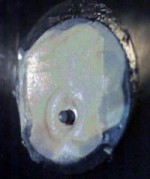
You might remember Rob Spence, known online as the Eyeborg for his project to create a working bionic eye. We wrote about him before, and interviewed him a while back, but the project has advanced to the point where even a seasoned tech blogger is left speechless with amazement.
Spence has worked with a team of engineers to adapt an endoscope into a working in-socket video camera. It’s turned on by waving a magnet near it, at which point it will begin transmitting a wireless video signal to a handheld LCD viewer. Absolutely incredible.
Watch the video from Sky News below, but be warned that it is slightly graphic. If you can’t handle someone installing and removing an artificial eye, consider this your warning.
Just astonishing that this is even possible. But really, this is more of a general achievement in miniaturization, not bionics. Endoscopic cameras with wireless transmitters are now commonplace; the enclosure and ergonomics of the device would be the hard part of this build. What’s yet to be accomplished with an artificial eye is hooking it up effectively to the visual cortex, and that is still years away from being practical — at least, for producing any kind of detail. Existing cortical microelectrode arrays just don’t have the density required, and as a result produce something only loosely definable as an image.
The timing of this new info is part of a media push for the new Deus Ex game (of GameStop infamy), in which cybernetics and prosthetics figure prominently — which doesn’t diminish the wonder of the thing, in my opinion. They also produced a short documentary about prosthetics and research in that field that’s worth a watch as well. It’s a very exciting field and the best bit is that they’re creating things that truly improve people’s lives. A prosthetic eye is a long way off, but it’s people with passion and dedication, like Spence and his team, who drive innovation, regardless of how far off the “final” product might be.
More information can be found at the Eyeborg Project’s home page.
Read More:
Video: “Eyeborg” Replaces Eye With Functioning Wireless Video Camera















 Artists often come up with concepts and ideas that require help to reach the light of day, and whenever an artist teams up with a scientist the unlikely duo is most likely on the verge of making an incredible discovery. Case and point-the collaboration between Dutch artist Jalila Essaidi and Utah State researcher Randy Lewis has resulted in a bulletproof, skin-like material that has been fabricated from silk threads produced by a genetically modified silk worm. And the ultimate point of this exercise in left brain/right brain cooperation? To someday create a synthetic human skin and artificial tendons and ligaments. Read more on this fascinating development over at PhysOrg.
Artists often come up with concepts and ideas that require help to reach the light of day, and whenever an artist teams up with a scientist the unlikely duo is most likely on the verge of making an incredible discovery. Case and point-the collaboration between Dutch artist Jalila Essaidi and Utah State researcher Randy Lewis has resulted in a bulletproof, skin-like material that has been fabricated from silk threads produced by a genetically modified silk worm. And the ultimate point of this exercise in left brain/right brain cooperation? To someday create a synthetic human skin and artificial tendons and ligaments. Read more on this fascinating development over at PhysOrg.